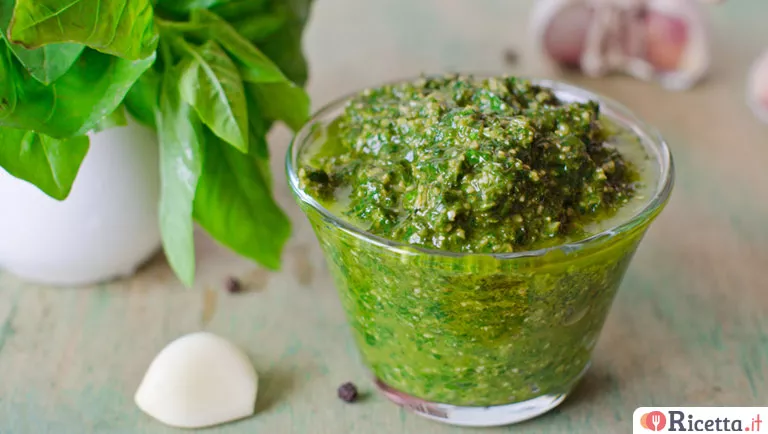Basil pesto is a cold sauce whose basic ingredient is basil. It has always been the pride of Ligurian cuisine and is appreciated everywhere.
The secret to obtaining a good homemade Genoese pesto is knowing how to dose all the ingredients that must strictly be of excellent quality: basil, cheese, extra virgin olive oil, garlic, and pine nuts.
The sauce is an excellent condiment for pasta but can also be enjoyed spread on croutons to complete an aperitif.
Tradition has it that the pesto is prepared with the appropriate mortar which best releases the essential oil and the aroma of the basil: we offer you a more practical and quicker but just as good version.
Let's see how to prepare the classic italian pesto, following the original recipe!
Category: Appetizers

[steprow1]
First, let's blanch the fresh basil leaves in a pot of water [1].
After that, drain and immediately transfer them to ice water [2]: the thermal shock allows the intense green color to be preserved. An alternative method is to freeze the leaves before using. In any case it is essential to dry the leaves very well and delicately without rubbing them, otherwise the basil will blacken making the pesto too dark and bitter in colour.
[steprow2]
In a blender, combine the pine nuts, garlic, pecorino and Parmesan [3] and add the perfectly dry basil leaves [4].
[steprow3]
Finally, pour in the extra virgin olive oil and salt [5]. Operate the blender at low speed, taking care to interrupt the appliance function several times to avoid excessive heating of the mixture.
Here is our basil pesto ready to be used! [6]
What's the best basil for pesto?
To prepare the pesto recipe it is preferable to use Genoese basil, it has wider leaves and a particular aroma that recalls the scent of lemon and jasmine. Make sure that the basil leaves are fresh, smooth and not "crumpled": you will thus avoid oxidation of the color which would make the cream of pesto too dark green.
How to prepare pesto with a mortar
Place the grains of coarse salt and the garlic cloves inside the mortar and start pounding with the appropriate wooden pestle.
Start adding the basil leaves a little at a time and continue working with the tool, with a gentle and prolonged rotating movement.
At this point, add the pine nuts, the Parmesan cheese and the pecorino, pour the extra-virgin olive oil drop by drop and continue to pound everything.
The operation is complete: the sweet and precious pesto sauce is ready. Pour it all into a glass container and, before placing it in the fridge, cover it with extra-virgin olive oil.
If you plan to enjoy homemade pesto on pasta, prefer trenette or homemade trofie.
How to store pesto?
You can store pesto in jars or airtight container in the refrigerator for about a week. You can also freeze it.
Pigato della liguria, a straw-yellow white with an intense aroma and dry taste. Vermentino is also excellent.
Any doubts or questions?
Share your experience